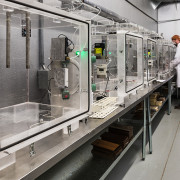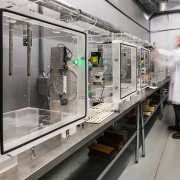A Primer for Understanding Formaldehyde Regulations
What is Formaldehyde?
Formaldehyde is a naturally occurring chemical found in homes and buildings (and in your body if you overindulge in alcohol). Fortunately, it breaks down in the environment and within our bodies quickly. It’s not all sunshine and rainbows, prolonged exposure to high levels of the compound can lead to respiratory issues and even cancer. Below is a list of common items that contain formaldehyde:
|
Examples of Common Environmental Emitters of Formaldehyde |
|||
| Plywood, MDF, Particleboard | Carpet | Insulation | Air Fresheners |
| Cigarettes/Tobacco | Glues and Resins | Gas Stoves/Ovens | Household Cleaners |
| Architectural/LVL Lumber | Fabric softeners | Engineered/Laminate Floors | Wood Stoves/Space Heaters |
| Wrinkle-Free Cloths | Personal Care Products | Furniture | Coatings and Finishes |
| Cabinetry | Latex Paint/Wallpaper | Fabric Softeners | Cosmetics |
Forest Products and Formaldehyde
There are many forest products that emit formaldehyde into the environment. All of these products fall into what is classified as composite wood products. They are products that are made by combining multiple pieces of wood together using glue. The resin or glue that holds the products together are often the reason for the emission. For decades formaldehyde was utilized to control the speed that a resin hardened and cured, the more formaldehyde, the faster the resin cured. As regulations were put into place, the amount of formaldehyde was decreased and the conditions and methods used to create the composite wood products were more closely monitored.
Who Regulates this Stuff?
In 1984, HUD 24 CFR 3280.308 became the standard for manufactured homes in the U.S. and regulated the amount of allowable formaldehyde that could come from a product. Fast forward to 2008, and the California Air Resources Board created CARB ATCM 93120, that regulates products that can be imported and sold into the state of California. The CARB rule, regulated the allowable limits of formaldehyde and created a system of Third Party Certifiers (TPC) that certify the process a manufacturer utilizes to meet the standard. In 2016, the Environmental Protection Agency (EPA) created the Toxic Substance Control Act (TSCA) Title VI, which regulates emission standards for all U.S. states and territories. TSCA Title VI also sets who can be a TPC and what the requirements of manufacturers, laminators, importers, distributors, and retailers are regarding the rule. Each set of rules, has their own detailed testing procedures, reporting standards, and document retention policies.
What is a TPC?
A TPC is an accredited company that verifies the accuracy of emission test procedures and facilities processes, evaluates and monitors the manufacturer/laminated product producer quality control programs, and provides independent audits and inspections of manufacturer/laminated product producer facilities. The TPCs must meet strict standards and be accredited to perform the duties required by the rules. Benchmark Holdings is an example of an accredited TPC for both CARB and TSCA Title VI.
What Does a TPC Do?
As part of both the requirements for TSCA Title VI and CARB ATCM 93120, TPCs evaluate the processes and procedures of companies who produce materials that fall under the rules. The TPC must perform a series of document reviews, laboratory and mill inspections, and product testing to make sure that all requirements are met. A mill’s process can then be certified, but certification is dependent on periodic testing, sampling, and inspections. Any failure to meet part of the requirements can lead to loss of certification.




